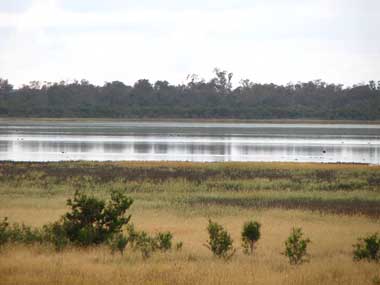The Muir-Byenup System Ramsar site is located inland 55 km south-east of the town of Manjimup in south-west Western Australia. The Ramsar site comprises a suite of partly inter-connected lakes and swamps in an internally draining catchment. The wetlands are varied in size, salinity (saline to fresh), permanence (seasonal to permanent) and substrate (peat and inorganic). The Ramsar wetland includes Lake Muir, Byenup Lagoon, Tordit-Gurrup Lagoon, Poorginup Swamp, Neeranup Swamp, Coorimup Swamp and Wimbalup Swamp and reserves in the surrounding area. Lake Muir is fringed by sedgelands, low samphire shrubland and Melaleuca dominated wetland scrub. The rest of the wetlands on the site are fringed by sedgelands, and Melaleuca, Astartea and Agonis shrublands. Eucalypts, such as Jarrah and Yate, dominate higher elevations. The site has a rich diversity of plants for such a small area, with over 600 native plant species recorded. This diversity may be due to the wide range of complexes of soil types and hydrological patterns found over short distances on the site. Three nationally vulnerable wetland-dependent orchids, the Harrington’s Spider-orchid, Christine’s Spider Orchid and Tall Donkey Orchid, also occur in the site. The Muir-Byenup System Ramsar site supports a large number and diversity of waterbirds, with more than 50 waterbird species recorded. Lake Muir is a migration stop-over site for shorebirds such as the Red-necked Stint. The open lakes are used for moulting by thousands of Australian Shelduck and as a drought refuge by large numbers of waterbirds. The Little Bittern, Spotless Crake, Australasian Bittern, Black Swan, Eurasian Coot and Silver Gull all breed at the site. Seven native fish species have been recorded in the site including the nationally vulnerable Balston’s Pygmy Perch. The site is located within a series of reserves for water and conservation of flora and fauna. The bird observatory on Muir Highway provides facilities for nature-based recreation such as bird watching. The wetlands are spiritually significant for the Noongar people.
Muir Byenup

Government evidence of impact of climate change:
-
Australian Government and WA Government Department of Environment and Conservation, Muir Byenup Ramsar Site, Ecological Character Description
Secondary salinity Disturbance of potential acid sulfate soils Eutrophication Grazing Introduced species Pathogens and pests Inappropriate fire regimes and; Illegal vehicle access. . . xii In the absence of complete knowledge; conservative limits of acceptable change have been set; which can be reviewed in light of monitoring and additional information.
Secondary salinity Disturbance of potential acid sulfate soils Eutrophication Grazing Introduced species Pathogens and pests Inappropriate fire regimes and; Illegal vehicle access. . . 7.1 Secondary salinity Wetlands; due to their low position in the landscape; are considered to be one of the first habitats to be impacted by rising groundwater and salinity (Gibson et al. 2004).
Includes key establish baseline information species (Balston’s Pygmy Perch; Mud Minnow for Lake Muir. and Black stripe Minnow) which meet Ramsar Research of fish lifecycles; criteria and provide food for waterbirds. mechanisms for drought Response of macroinvertebrates to salinity and avoidance and salt tolerance acidity will also assist in setting limits of to determine fish community acceptable change.
Potential acidity (pyrite in aquifers) Wetland ecosystem Hydrology Smaller lakes and swamps (Byenup; Tordit Gurrup and Poorginup) and interconnected flats Coorinup acts as shallow evaporating basin (fresh when flooded) Surface water areas and depths seasonal Byenup permanent; others permanent or near permanent Physical form Erosion (P) Sedimentation (P) Soil type (C) Morphology (C) O Biochemical processing (P) Nutrient and carbon cycling Water quality (C) Poorginup fresh; other wetlands brackish saline (0.65 42.2ppt) Increased salinity in summer Poorginup acidic (pH 5.5 6) Other wetlands (pH 7 9) Fres Flora and fauna (C) Waterbirds Drought refuge (Tordit Gurrup); Australian Shelduck moulting Breeding (Black Swans; Spotless Crake; Australasian and Little Bitterns and Eurasian Coots) (C4) 1 Australasian Bitterns (C3) Flora (habitat) water macrophytes Baumea sedgelands Melaleuca rhaphiophylla; M. lateritia; Astartea leptophylla and Taxandria juniperina shrublands Eucalyptus marginata IE.occidentalis and E. rudis Priority endemic species (C3) Fauna Balston’s Pygmy Perch (C2) 32 Endemic macroinvert. (C3) .
COMPONENT BASELINE SUPPORTING EVIDENCE LIMIT OF ACCEPTABLE CHANGE Abiotic components Depth Wetlands should not dry out to avoid acidification of acid sulfate soils and to maintain macroinvertebrate communities.


